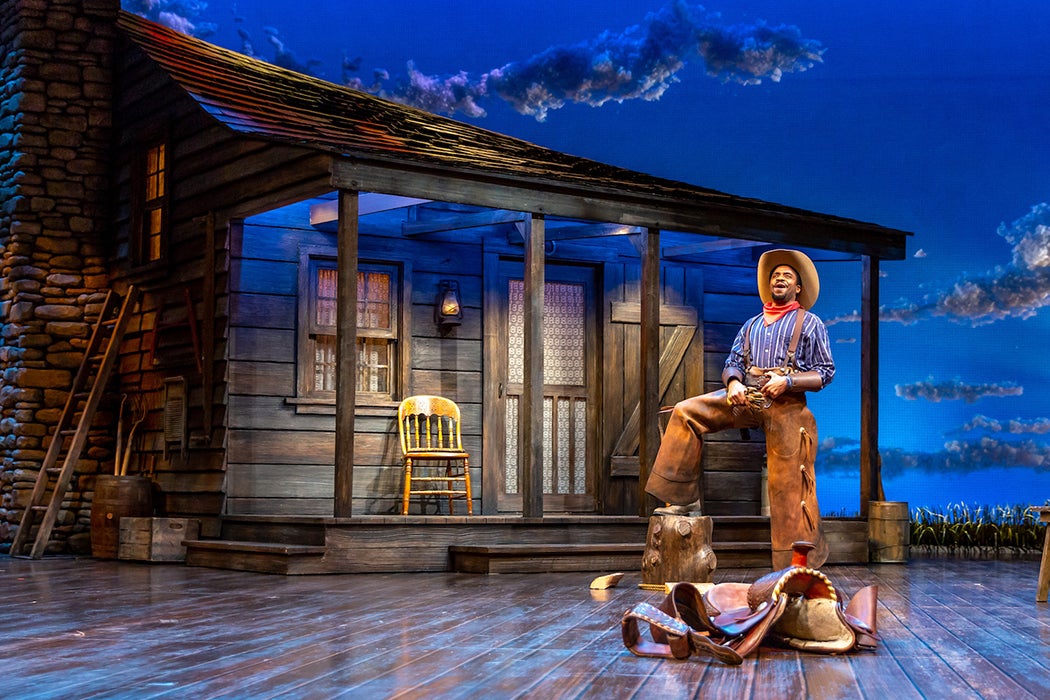A same-sex Oklahoma!? That’s what theatergoers recently saw at the Oregon Shakespeare Festival in Ashland. And an ongoing Denver production features an all-black cast. They’re both examples of productions breathing new life into a show that’s become an old hat. But once upon a time, Oklahoma! shook up the world of musical theater by “integrating” music, dance, and dialogue.
Or did it? Musicologist James O’Leary isn’t so sure. He calls the narrative of integration “increasingly suspect,” drawing on the history of the show’s publicity and reception.
The Rodgers and Hammerstein show, which tells the story of rival lovers in turn-of-the-century Oklahoma Territory, premiered in March 1943 at the Theatre Guild, which was struggling financially. The Guild had put on only one other musical, Porgy and Bess, which they advertised as an opera and which flopped spectacularly. And so, writes O’Leary, they touted Oklahoma! as something new and different.
But Oklahoma! was not as different as it seemed. In fact, notes O’Leary, the Guild had essentially promoted Porgy and Bess as weaving together song and story. The show, the Guild bragged, was serious and highbrow. That approach may have played up the opera’s actual attributes, but it didn’t sell tickets. With early advertisements for Oklahoma!, the Guild focused on entertainment, not its seriousness.
Promoters started using essays from Hammerstein along with their own publicity. Hammerstein discussed how he had used speech and music to bridge gaps between songs and how the show’s dialogue, lyrics, and music were integrated together. He used the concept of “integration” to underscore the folksy attributes of the show, whose “authentic frontier tone,” in O’Leary’s words, was different from anything that had come before it.
Promoters called the show a “musical play” instead of a “musical comedy,” an important distinction that emphasized the ways in which Oklahoma! was different from anything else on Broadway. As Hammerstein and the Guild continued to promote the show, they leaned more and more on a highbrow interpretation of the various elements onstage, abandoning talk of its folksiness and throwing in a few jabs at the supposedly inane world of musical comedy in the process.
Want more stories like this one?
O’Leary dives into the era’s cultural criticism, including a longstanding debate about high-, middle-, and lowbrow theater. Ultimately, he writes, musical theater was solidly middlebrow, but portrayed itself as high art. Promoters used stereotypes associated with all three categories when boosting new shows, and Oklahoma! was no exception. Hammerstein, especially, became adept at fusing the show’s folk aspects with its upmarket music, delivery, and “integration.” O’Leary writes that Hammerstein “expertly navigated cultural territories, subtly wedding highbrow theories to lowbrow rhetoric, in order to appeal to as many critics and patrons as possible.”
Slowly but surely, the show’s critics began writing about the ways it “transcended…Broadway genre and venue to become something that was somehow aesthetically elevated.” And though critics were often unclear on what gave it that transcendent quality, those descriptions became part of the show’s reputation. As more critics expressed those views, the Guild caught on and reflected them back to the press and to potential audiences.
So maybe Oklahoma!‘s famed “integration” was largely a marketing ploy. This year’s new productions suggest that the show’s greatest strength isn’t the way it integrates music and dialogue at all: It’s how it serves as a blank slate to generation after generation, a wall upon which each decade’s preoccupations can be projected.







